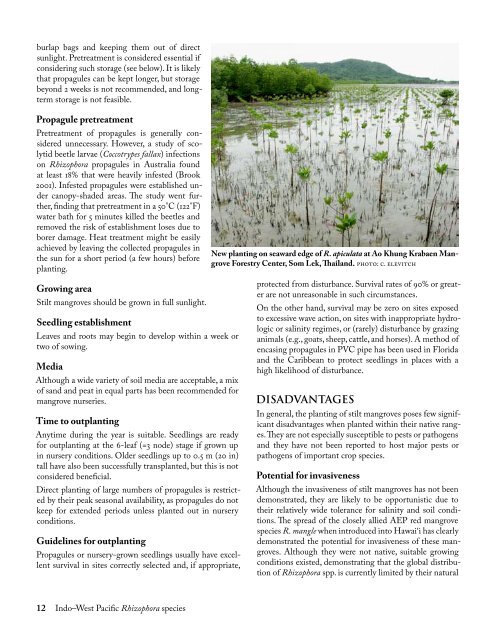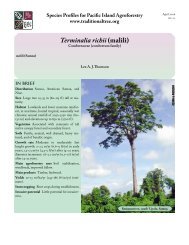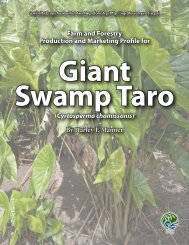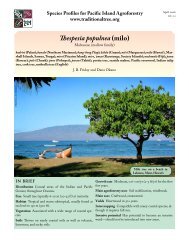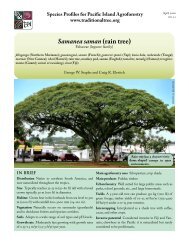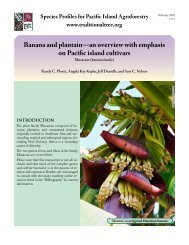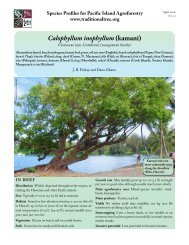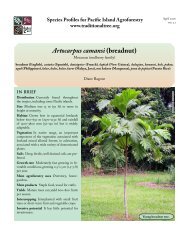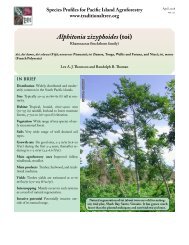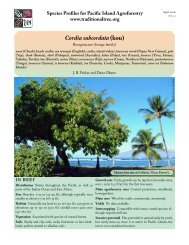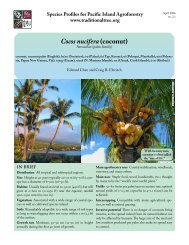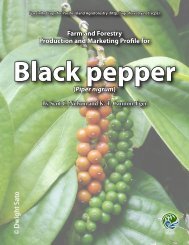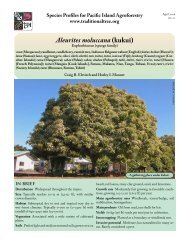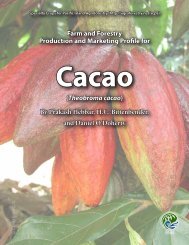Rhizophora apiculata, R. mucronata, R. stylosa, R ... - Agroforestry Net
Rhizophora apiculata, R. mucronata, R. stylosa, R ... - Agroforestry Net
Rhizophora apiculata, R. mucronata, R. stylosa, R ... - Agroforestry Net
You also want an ePaper? Increase the reach of your titles
YUMPU automatically turns print PDFs into web optimized ePapers that Google loves.
urlap bags and keeping them out of direct<br />
sunlight. Pretreatment is considered essential if<br />
considering such storage (see below). It is likely<br />
that propagules can be kept longer, but storage<br />
beyond 2 weeks is not recommended, and longterm<br />
storage is not feasible.<br />
Propagule pretreatment<br />
Pretreatment of propagules is generally considered<br />
unnecessary. However, a study of scolytid<br />
beetle larvae (Coccotrypes fallax) infections<br />
on <strong>Rhizophora</strong> propagules in Australia found<br />
at least 18% that were heavily infested (Brook<br />
2001). Infested propagules were established under<br />
canopy-shaded areas. The study went further,<br />
finding that pretreatment in a 50°C (122°F)<br />
water bath for 5 minutes killed the beetles and<br />
removed the risk of establishment loses due to<br />
borer damage. Heat treatment might be easily<br />
achieved by leaving the collected propagules in<br />
the sun for a short period (a few hours) before<br />
planting.<br />
Growing area<br />
Stilt mangroves should be grown in full sunlight.<br />
Seedling establishment<br />
Leaves and roots may begin to develop within a week or<br />
two of sowing.<br />
Media<br />
Although a wide variety of soil media are acceptable, a mix<br />
of sand and peat in equal parts has been recommended for<br />
mangrove nurseries.<br />
Time to outplanting<br />
Anytime during the year is suitable. Seedlings are ready<br />
for outplanting at the 6-leaf (=3 node) stage if grown up<br />
in nursery conditions. Older seedlings up to 0.5 m (20 in)<br />
tall have also been successfully transplanted, but this is not<br />
considered beneficial.<br />
Direct planting of large numbers of propagules is restricted<br />
by their peak seasonal availability, as propagules do not<br />
keep for extended periods unless planted out in nursery<br />
conditions.<br />
Guidelines for outplanting<br />
Propagules or nursery-grown seedlings usually have excellent<br />
survival in sites correctly selected and, if appropriate,<br />
1 Indo–West Pacific <strong>Rhizophora</strong> species<br />
New planting on seaward edge of R. <strong>apiculata</strong> at Ao Khung Krabaen Mangrove<br />
Forestry Center, Som Lek, Thailand. photo: C. elevitCh<br />
protected from disturbance. Survival rates of 90% or greater<br />
are not unreasonable in such circumstances.<br />
On the other hand, survival may be zero on sites exposed<br />
to excessive wave action, on sites with inappropriate hydrologic<br />
or salinity regimes, or (rarely) disturbance by grazing<br />
animals (e.g., goats, sheep, cattle, and horses). A method of<br />
encasing propagules in PVC pipe has been used in Florida<br />
and the Caribbean to protect seedlings in places with a<br />
high likelihood of disturbance.<br />
DISADVANTAGES<br />
In general, the planting of stilt mangroves poses few significant<br />
disadvantages when planted within their native ranges.<br />
They are not especially susceptible to pests or pathogens<br />
and they have not been reported to host major pests or<br />
pathogens of important crop species.<br />
Potential for invasiveness<br />
Although the invasiveness of stilt mangroves has not been<br />
demonstrated, they are likely to be opportunistic due to<br />
their relatively wide tolerance for salinity and soil conditions.<br />
The spread of the closely allied AEP red mangrove<br />
species R. mangle when introduced into Hawai‘i has clearly<br />
demonstrated the potential for invasiveness of these mangroves.<br />
Although they were not native, suitable growing<br />
conditions existed, demonstrating that the global distribution<br />
of <strong>Rhizophora</strong> spp. is currently limited by their natural


